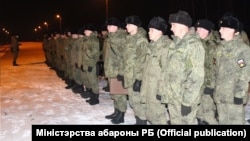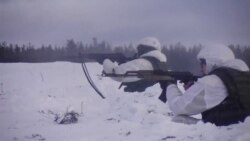As Russia has moved tens of thousands of troops toward its border with Ukraine in recent months, hinted of an armed response if NATO does not acquiesce to its demands, and announced large military exercises in Belarus, the sheer scale of its mobilization has been hard for Moscow to downplay or deny.
The reason: Unlike in decades past, experts say the surveillance tools available today make it impossible for a modern army to stage a major logistical operation without alerting the global community. And often, the alarm bells are rung by a network of dedicated sleuths who are first to unearth evidence on the ground.
When Russia announced the joint exercises on the territory of its staunch ally Belarus this month, it was analysts from the Conflict Intelligence Team (CIT), an open-source investigative outlet, that filled in the gaps left by a lack of clarity from Moscow, revealing credible estimates that some 8,000 to 15,000 troops were involved and placing the West further on edge.
“Many soldiers and their relatives are writing in social media that they’re being sent to Belarus for training,” Kirill Mikhailov, a CIT analyst, told Current Time on January 19. “The fact that those forces will now be added is a pretty serious sign.”
An investigation by CIT and RFE/RL’s Russian Service, published this week, provided further evidence of movement of Russian forces westward across the country, toward Belarus and Ukraine.
Information of this sort is crucial for Western governments preparing a possible response to any invasion Russia may stage in coming months. And CIT is not the only outfit helping them piece things together. Amateur sleuths and open-source investigators working for private organizations and NGOs are tracking Russia’s mobilization 24/7, trawling social media platforms and compiling commercial satellite imagery to deliver evidence about what’s going on.
One of these invaluable sources is Maxar Technologies, a commercial satellite and imaging company that has exposed Russia’s growing buildup on its border with Ukraine and in Crimea. Since late November, it has supplied the world’s leading outlets with images attesting to a Russian buildup that Moscow can no longer plausibly deny.
Increasingly Untenable Denials
When Russia sent forces to seize control of Crimea from Ukraine in February 2014, its actions were accompanied by repeated denials -- including from President Vladimir Putin -- that the so-called “little green men” patrolling Ukrainian Army bases on the Black Sea peninsula are actually regular Russian troops.
Later, when it fomented an armed uprising by Moscow-backed separatist forces in the Donbas region of eastern Ukraine, it came down to journalists operating on the ground to supply evidence that the troops and equipment sent to shore up the insurgency came from Russia.
Fast forward eight years and the quality of satellite imagery, as well as the ubiquity of revealing social media posts, means such denials have become increasingly untenable and it has become far easier for Western analysts and digital activists to debunk them.
And while the use of open-source intelligence is by no means new, the price of acquiring satellite and flight-tracking data has plummeted in recent years, markedly expanding the number of citizens who can gain access to such information and publish what they find online.
What they find, very often, is precious video evidence showing the movement of Russian troops and equipment from the country’s remote Far East westward to the border with Ukraine and now also to Belarus, which announced the joint exercises that are slated to begin on February 9.
The investigation by CIT and RFE/RL’s Russian Service used an analysis of Russian-language social media posts to shed light on the scale and nature of Moscow’s military mobilization and spotlight concerns voiced by the relatives of troops headed westward for deployment in Belarus and on Russia’s borders with Ukraine.
The investigation, based in part on reactions to numerous posts on the video-sharing platform TikTok by people who appear to be Russian soldiers as well as exchanges with friends and relatives who authored some of the comments, added crucial evidence of the Russian military buildup as negotiations between Russia and the West continue to yield no breakthrough.
The Job Is Becoming Harder
The accuracy of information dug up by many independent sleuths and amplified by mainstream media allows such private analysts to be “roughly on the same page” as the U.S. intelligence community, said former CIA analyst Jeffrey Edmonds.
“It’s impressive how close someone can be on the outside,” Edmonds, now at the CNA Corp think-tank, told The Wall Street Journal earlier this month.
But their job is becoming harder. Analysts say that Russia has become more skilled in obscuring its activities since its operations in 2014 and its more recent military buildup in the spring of 2021, deploying tactics such as painting over Russian flags on vehicles and removing their license plates so as to hide their origins.
In May 2020, Putin signed a decree that forbids Russian soldiers from carrying smartphones while on duty, a direct response to the huge embarrassment Moscow suffered after hundreds of posts by troops active in the military campaigns in eastern Ukraine in 2014 and 2015.
But analysts at CIT remain upbeat about the prospects of keeping track of Russia’s troop movements as the risk of an escalation continues to rise.
“Since the beginning of January, a whole wave of videos and social media posts has surfaced showing that troops are moving,” CIT founder Ruslan Leviev told Current Time. “And local residents, for whom this is unusual, are of course documenting it all.”
But Leviev, a long-time open-source investigator who has riled Russian authorities and reported being attacked near his home in Moscow by unknown assailants in 2019, warns that the scale of Russia’s buildup does not bode well.
“Russia tried to justify itself, saying these are just exercises,” he said of the deployments to Belarus. “But experience shows that exercises can easily turn directly into real military operations.













